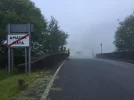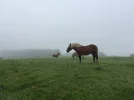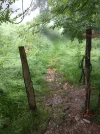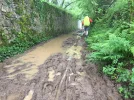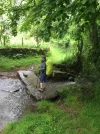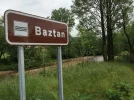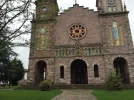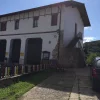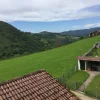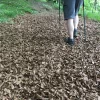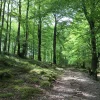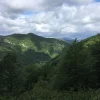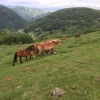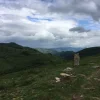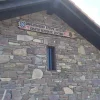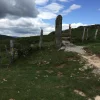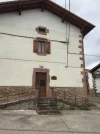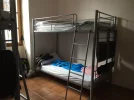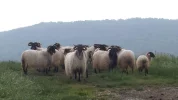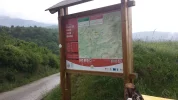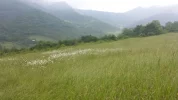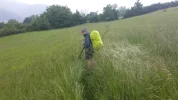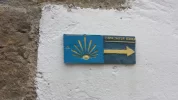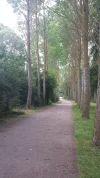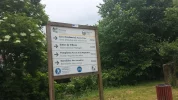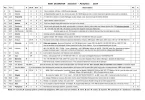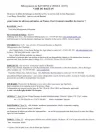- Time of past OR future Camino
- A few and hopefully lots more.
Edits: I've made some changes to these posts, following the '5 peregrinas' Camino del Baztán in May 2017.
As promised in my 'overview' post, here’s a more detailed summary of our stages on the Camino del Baztan. Caveats: This is not meant as a guide (my previous post lists some useful guides). It's a very subjective account of our experience and the highs and lows. Where I've included walking notes, they are for the bits that we found a little tricky.
The landscape and weather were key elements of our experience, so it would be interesting to return to this Camino at a different time of year – possibly in autumn or spring. Another important consideration was the day on which we set out (a Friday). This meant that we walked through some of the more remote places on Sunday and Monday, when most shops and bars are closed. Not the end of the world, but I would probably plan it a little differently next time. Yes, I’m already thinking about going back ……
As I said in the earlier post, 5 days worked fine. However, if you aren’t short of time, a 6-day slower walk would be a real treat.
Day 0 – Bayonne
We flew from Dublin to Biarritz with Ryanair and took the airport bus to Bayonne (€1, takes about 30 mins, pay the driver).
Bayonne is a nice city for wandering and for people-watching. We picked up our pilgrim passports and first stamps at the Cathedral. There’s a desk just inside the door on the left hand side (open 09.00-12.00 and 15.00 to 18.00). They also gave us some useful information about the route and accommodation.
Restaurant recommendation – we had a really nice meal in a traditional Basque restaurant, l’Auberge du Petit Bayonne: http://auberge-du-petit-bayonne.fr Lovely people.
Day 1: Bayonne to Esplette (about 24kms).
The route out of Bayonne is pretty easy to find – just keep the river Nive (the smaller of the two rivers) on your left hand side. You’ll pass the riverside restaurants and join a track that is popular with runners and cyclists. The first route markings appear as you walk under a big road bridge. There are signs for a number of different walking routes, so over the next couple of days, always make sure that you follow the correct ones!
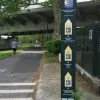
About 6kms from Bayonne, there’s an equestrian centre with a bar and accommodation: http://www.nivheberge64.com/lheberge-de-la-nive/ It might be an alternative to spending the first night in Bayonne (although there’s nothing else nearby).
The path continues along the river Nive for much of the way to Ustaritz (14kms from Bayonne). It is really well marked and any time we were unsure of where to go, there was an arrow pointing the way, and often an X showing the incorrect route.
On the final approach to Ustaritz, there’s a pizzeria and a bakery on the left hand side. There are more bars and shops in the centre of the village. As before, the route is well marked. When leaving the village, pass the church on the right hand side (its grounds offer a short but welcome respite from the asphalt).
After Ustaritz, the terrain changes with a few ‘ups and downs’, but nothing too serious. There’s mix of asphalt, gravel and muddy forest tracks, with a few fallen branches and other obstacles. The route is well marked – however, in the final stages you need to watch for the signs to Esplette, rather than Souraide:
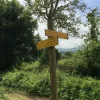
NB: It's important to pay attention to the route into Esplette, as you’ll need to retrace it the next morning and there aren’t any arrows to follow.
Esplette isn’t actually on the Camino, but it’s a popular alternative to nearby Souraide, as there's a 12-bed municipal Gite de Pelerins. Accommodation is in 2 rooms, with single beds and bunks. It’s a little outside the centre, above a crèche. It was clean and comfortable, with an adequate kitchen and plenty of hot water. €15 per bed (and not €10 as most guide state). Some photos:
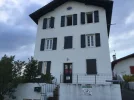
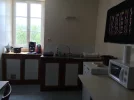
This hostel also serves pilgrims walking from St Jean Pied de Port to Irun (typically Le Puy pilgrims connecting to the Camino del Norte). You pay at the tourist office, where you get directions to the gite and a code for the external door. It can fill up quickly. We didn’t book ahead, but the girl in the the tourist office made it clear that we should perhaps have done so. Telephone number: +33 559939502.
May 2017 update: The family-run Hotel Euzkadi has a pilgrim rate that includes dinner and breakfast. It was €50 per person in May 2017. It was very nice, especially after a long wet day.
Esplette is a very pretty Basque village, famous for its peppers. It also has a chocolate factory, with a shop selling all kinds of fancy chocolates and giving plenty of free samples! Overall, it’s a very touristy place, catering mainly for day-trippers. It has plenty of places to eat, a small supermarket, a good boulangerie and some nice deli/cheese/wine shops.
Day 2: Esplette to Amiaur/Maya (about 24kms).
As Esplette isn’t on the Camino, there are no arrows to guide you out of the village. There are signs for many other walking routes, so it can be quite confusing. Warning - don't follow the shells or Camino signs - they are not for the Camino del Baztan!
Leave the village by retracing your steps. Just before a garage, there’s a sign directing pilgrims to turn right (again, retracing steps from yesterday) to Souraide. Alternatively, you can avoid this detour to Souraide and remain on the road for about 3kms, rejoining the Camino by turning left and following the signs for Voie du Bastan and Ainhoa. There are a few points with signs for different walking routes, so make sure you follow the Baztan/Bastan ones.
May 2017 update - we used online maps to follow a country road that ran parallel to the main road (which we could see to our right) and joined the Camino without any need to walk on the main road.
Ainhoa is another pretty Basque village, and a nice coffee/foot-care stop before the border with Spain. The route out of Ainhoa is well marked but once again, take care to follow the correct arrows.
After a couple of kilometers, cross a river and enter Spain through the old (unmanned) border checkpoint. Just follow the road signs for Pamplona/Urdax and pass the petrol stations and big stores, which seemed to be full of French shoppers availing of the lower prices in Spain. Continue straight on, through a series of (about 5) roundabouts. As the long line of commercial premises comes to an end, turn right here:
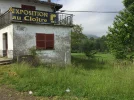 and follow a short muddy/overgrown track, before turning left on to an concrete path. This brings you to an intersection with a road, where you turn right. After that, follow the arrows and turn left onto a concrete path, leading eventually to Urdax.
and follow a short muddy/overgrown track, before turning left on to an concrete path. This brings you to an intersection with a road, where you turn right. After that, follow the arrows and turn left onto a concrete path, leading eventually to Urdax.
Urdax is a pleasant and well-maintained village. Like Esplette, it seems to cater mainly for tourists and day-trippers. There’s a pilgrim albergue in the monastery at the entrance to the village. The monastery is now an exhibition centre and the staff don’t take anything to do with the albergue (they were confused when I asked for a sello). To stay in the albergue, phone the number on the door.
A youtube video about the albergue:
We stopped for a break in Urdax and bathed our feet in the little stream. We also had really nice tapas in Café Montxo, which was a happy reminder of the difference in prices between France and Spain. Two green teas and two generously sized tapas cost just €5. Similar food in Esplette the previous day cost more than twice that amount.
When leaving Urdax, cross the little bridge (the monastery and tourist office will be on your right). You'll immediately see signs and arrows directing you to a path/cattle grid into the forest, and the first of the two steep climbs on the Camino del Baztan.
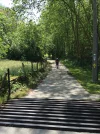
In spite of our best intentions, we ended up doing this climb (500m over 5.5kms) in the hottest part of the day. Not a good idea, but the trees provided a degree of shade from the sun. There were some really nice views along the way, but it was still a pretty tiring walk. Most of the arrows are on trees. There was only one point where we got a bit confused, as we reached a ‘junction’ and saw two signs for walking back to Urdax. The correct onward route is straight ahead, over a stile and through a newly planted area.
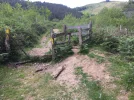
At this point, the worst of the climb is done and you'll soon reach a shaded picnic area with public toilets. We sat there for a while before crossing the road and joining the path/road leading all the way to Amaiur/Maya.
We stayed at Pension Goiz Argi, €47 for a small double room with en-suite bathroom. This included the use of a sitting room, a well equipped kitchen, a washing machine and an area to dry clothes. Had I known about the kitchen, I would have bought food before arriving!
Amauir is a tiny village, with a restored mill and two bars (one of which was closed). We enquired about food in the small bar on the main street. The lady told us that she would make us something if we came back at 8pm. We happily did so and she made a big ensalada mixta and a sharing plate of fried eggs, fried potato and bacon. She also used the local teenagers to help with translation, as my Spanish is very basic. We ended up having a really enjoyable evening, with the thunder and lightning storms providing extra entertainment!
Rush hour in Amiur!
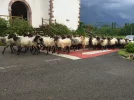
As promised in my 'overview' post, here’s a more detailed summary of our stages on the Camino del Baztan. Caveats: This is not meant as a guide (my previous post lists some useful guides). It's a very subjective account of our experience and the highs and lows. Where I've included walking notes, they are for the bits that we found a little tricky.
The landscape and weather were key elements of our experience, so it would be interesting to return to this Camino at a different time of year – possibly in autumn or spring. Another important consideration was the day on which we set out (a Friday). This meant that we walked through some of the more remote places on Sunday and Monday, when most shops and bars are closed. Not the end of the world, but I would probably plan it a little differently next time. Yes, I’m already thinking about going back ……
As I said in the earlier post, 5 days worked fine. However, if you aren’t short of time, a 6-day slower walk would be a real treat.
Day 0 – Bayonne
We flew from Dublin to Biarritz with Ryanair and took the airport bus to Bayonne (€1, takes about 30 mins, pay the driver).
Bayonne is a nice city for wandering and for people-watching. We picked up our pilgrim passports and first stamps at the Cathedral. There’s a desk just inside the door on the left hand side (open 09.00-12.00 and 15.00 to 18.00). They also gave us some useful information about the route and accommodation.
Restaurant recommendation – we had a really nice meal in a traditional Basque restaurant, l’Auberge du Petit Bayonne: http://auberge-du-petit-bayonne.fr Lovely people.
Day 1: Bayonne to Esplette (about 24kms).
The route out of Bayonne is pretty easy to find – just keep the river Nive (the smaller of the two rivers) on your left hand side. You’ll pass the riverside restaurants and join a track that is popular with runners and cyclists. The first route markings appear as you walk under a big road bridge. There are signs for a number of different walking routes, so over the next couple of days, always make sure that you follow the correct ones!

About 6kms from Bayonne, there’s an equestrian centre with a bar and accommodation: http://www.nivheberge64.com/lheberge-de-la-nive/ It might be an alternative to spending the first night in Bayonne (although there’s nothing else nearby).
The path continues along the river Nive for much of the way to Ustaritz (14kms from Bayonne). It is really well marked and any time we were unsure of where to go, there was an arrow pointing the way, and often an X showing the incorrect route.
On the final approach to Ustaritz, there’s a pizzeria and a bakery on the left hand side. There are more bars and shops in the centre of the village. As before, the route is well marked. When leaving the village, pass the church on the right hand side (its grounds offer a short but welcome respite from the asphalt).
After Ustaritz, the terrain changes with a few ‘ups and downs’, but nothing too serious. There’s mix of asphalt, gravel and muddy forest tracks, with a few fallen branches and other obstacles. The route is well marked – however, in the final stages you need to watch for the signs to Esplette, rather than Souraide:

NB: It's important to pay attention to the route into Esplette, as you’ll need to retrace it the next morning and there aren’t any arrows to follow.
Esplette isn’t actually on the Camino, but it’s a popular alternative to nearby Souraide, as there's a 12-bed municipal Gite de Pelerins. Accommodation is in 2 rooms, with single beds and bunks. It’s a little outside the centre, above a crèche. It was clean and comfortable, with an adequate kitchen and plenty of hot water. €15 per bed (and not €10 as most guide state). Some photos:


This hostel also serves pilgrims walking from St Jean Pied de Port to Irun (typically Le Puy pilgrims connecting to the Camino del Norte). You pay at the tourist office, where you get directions to the gite and a code for the external door. It can fill up quickly. We didn’t book ahead, but the girl in the the tourist office made it clear that we should perhaps have done so. Telephone number: +33 559939502.
May 2017 update: The family-run Hotel Euzkadi has a pilgrim rate that includes dinner and breakfast. It was €50 per person in May 2017. It was very nice, especially after a long wet day.
Esplette is a very pretty Basque village, famous for its peppers. It also has a chocolate factory, with a shop selling all kinds of fancy chocolates and giving plenty of free samples! Overall, it’s a very touristy place, catering mainly for day-trippers. It has plenty of places to eat, a small supermarket, a good boulangerie and some nice deli/cheese/wine shops.
Day 2: Esplette to Amiaur/Maya (about 24kms).
As Esplette isn’t on the Camino, there are no arrows to guide you out of the village. There are signs for many other walking routes, so it can be quite confusing. Warning - don't follow the shells or Camino signs - they are not for the Camino del Baztan!
Leave the village by retracing your steps. Just before a garage, there’s a sign directing pilgrims to turn right (again, retracing steps from yesterday) to Souraide. Alternatively, you can avoid this detour to Souraide and remain on the road for about 3kms, rejoining the Camino by turning left and following the signs for Voie du Bastan and Ainhoa. There are a few points with signs for different walking routes, so make sure you follow the Baztan/Bastan ones.
May 2017 update - we used online maps to follow a country road that ran parallel to the main road (which we could see to our right) and joined the Camino without any need to walk on the main road.
Ainhoa is another pretty Basque village, and a nice coffee/foot-care stop before the border with Spain. The route out of Ainhoa is well marked but once again, take care to follow the correct arrows.
After a couple of kilometers, cross a river and enter Spain through the old (unmanned) border checkpoint. Just follow the road signs for Pamplona/Urdax and pass the petrol stations and big stores, which seemed to be full of French shoppers availing of the lower prices in Spain. Continue straight on, through a series of (about 5) roundabouts. As the long line of commercial premises comes to an end, turn right here:
 and follow a short muddy/overgrown track, before turning left on to an concrete path. This brings you to an intersection with a road, where you turn right. After that, follow the arrows and turn left onto a concrete path, leading eventually to Urdax.
and follow a short muddy/overgrown track, before turning left on to an concrete path. This brings you to an intersection with a road, where you turn right. After that, follow the arrows and turn left onto a concrete path, leading eventually to Urdax.Urdax is a pleasant and well-maintained village. Like Esplette, it seems to cater mainly for tourists and day-trippers. There’s a pilgrim albergue in the monastery at the entrance to the village. The monastery is now an exhibition centre and the staff don’t take anything to do with the albergue (they were confused when I asked for a sello). To stay in the albergue, phone the number on the door.
A youtube video about the albergue:
We stopped for a break in Urdax and bathed our feet in the little stream. We also had really nice tapas in Café Montxo, which was a happy reminder of the difference in prices between France and Spain. Two green teas and two generously sized tapas cost just €5. Similar food in Esplette the previous day cost more than twice that amount.
When leaving Urdax, cross the little bridge (the monastery and tourist office will be on your right). You'll immediately see signs and arrows directing you to a path/cattle grid into the forest, and the first of the two steep climbs on the Camino del Baztan.

In spite of our best intentions, we ended up doing this climb (500m over 5.5kms) in the hottest part of the day. Not a good idea, but the trees provided a degree of shade from the sun. There were some really nice views along the way, but it was still a pretty tiring walk. Most of the arrows are on trees. There was only one point where we got a bit confused, as we reached a ‘junction’ and saw two signs for walking back to Urdax. The correct onward route is straight ahead, over a stile and through a newly planted area.

At this point, the worst of the climb is done and you'll soon reach a shaded picnic area with public toilets. We sat there for a while before crossing the road and joining the path/road leading all the way to Amaiur/Maya.
We stayed at Pension Goiz Argi, €47 for a small double room with en-suite bathroom. This included the use of a sitting room, a well equipped kitchen, a washing machine and an area to dry clothes. Had I known about the kitchen, I would have bought food before arriving!
Amauir is a tiny village, with a restored mill and two bars (one of which was closed). We enquired about food in the small bar on the main street. The lady told us that she would make us something if we came back at 8pm. We happily did so and she made a big ensalada mixta and a sharing plate of fried eggs, fried potato and bacon. She also used the local teenagers to help with translation, as my Spanish is very basic. We ended up having a really enjoyable evening, with the thunder and lightning storms providing extra entertainment!
Rush hour in Amiur!

Last edited:




